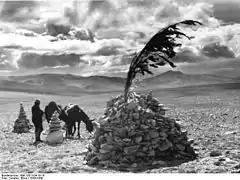Ovoo
Un ovoo (mongol : ᠥᠪᠥᠭᠭᠠ, VPMC : öbôɣɣa, cyrillique : овоо, MNS : ovoo), signifiant « talus de pierre », parfois orthographié obo, est un cairn[1] utilisé au sein de la culture chamanique mongole, notamment pour les sacrifices d'animaux aux déités des montagnes.

Aire de diffusion et usages
On en trouve majoritairement en Mongolie et les régions chinoises de Mongolie-Intérieure où la culture mongole est omniprésente.
Les Mongours de l'est du Qinghai honorent leurs divinités des montagnes au moyen de l'ovoo. Au sommet d'une montagne sacrée, on plante, à l'occasion de tsagaan Sar (équivalent de la fête du printemps chez les Mongols), un poteau censé permettre aux hommes de communiquer avec ces esprits. Autour du poteau, on empile des pierres, de préférence blanches, en un tas palissadé dans lequel on fiche des épieux, de longues flèches et des branches de cyprès. Des drapeaux de prière sont fixés au poteau et aux autres bouts de bois. À des cordes fixées au mât, on attache des os de mouton, de petits drapeaux de prière et des lambeaux de laine rouges. Souvent, des tas plus petits sont élévés à côté du tas central, devant lequel on a posé de grandes dalles pour servir de table à offrandes. Un mouton y sera sacrifié devant les villageois présents[2].
Les populations kalmoukes de la Fédération de Russie, qui sont d'origine mongole et pratiquent le bouddhisme tibétain mêlé de chamanisme, élèvent, elles aussi, des ovoo, censés abriter les esprits des lieux et servant à accomplir divers rituels[3].
Au Tibet et dans le reste de l'espace himalayen tibétophone on les appelle Lhapsa[4].
Ovoo et lhapsa sont souvent dressés au col : le voyageur s'y arrête et ajoute sa pierre au tas pour manifester sa gratitude de ce que le voyage se passe bien[5].
Selon Gaëlle Lacaze, le culte des ovoo se généralisa pendant le premier tiers du XIXe siècle à la suite de l'intensification de la campagne de conversions au bouddhisme. Les ovoo se substituèrent aux « marques chamaniques du culte des ancêtres ». Toutefois, en se pérennisant dans les pratiques populaires mongoles, ce culte a perdu aujourd'hui ses connotations bouddhiques[6].
 Ovoo en bois.
Ovoo en bois. Ovoo dans l'aïmag d'Övörhangay.
Ovoo dans l'aïmag d'Övörhangay. Ovoos sur le Mont Riyue, Qinghai.
Ovoos sur le Mont Riyue, Qinghai.
 Ovoo composé d'un poteau vertical au bord du lac Qinghai.
Ovoo composé d'un poteau vertical au bord du lac Qinghai.
 Cairn au passage du col de Nathu (Ernst Schäfer, 1939).
Cairn au passage du col de Nathu (Ernst Schäfer, 1939). ovoo du mausolée de Genghis Khan à Ordos
ovoo du mausolée de Genghis Khan à Ordos
Notes et références
- (en) Daniel Miller and Dennis Sheehy, The relevance of Owen Lattimore's writings for nomadic pastoralism research and development in inner Asia, in Nomadic Peoples, vol. 12, issue 2, 2008, p. 103-115 : « Anyone who has spent time in Mongolia is familiar with an obo (cairn) and their special significance in the landscape ».
- (en) Louis M. J. Schram, with Owen Lattimore, The Monguors of the Kansu-Tibetan Frontier: Their Origin, History, and Social Organization, Édition réimprimée, Kessinger Publishing, 2006, section « Cult of the Obo », p. 453-455 : « A mountain god is honored by means of an Obo. On the top of the sacred mountain is planted a big pole which secures communication between spirits and man, even as at the time of the shamanist feast of spring, and the planting of the manikan in the courtyards. Stones, mostly white ones, are piled in a big heap around the pole, enclosed with a wooden fence, painted white. Sticks, very often shaped as spears and long arrows, often painted red at the top and black at the bottom, with a tassel of red wool attached to them, are planted in the stone heap, as well as some twigs of cypress. On the top of the pole, and on most of the sticks, are fixed prayer flags, pieces of white cloth on which prayers are written with Tibetan characters, and with the “Wind Horse” printed on them. To white and black ropes (of which one end is bound to the pole and the other to small poles or sticks fixed in the ground), are attached some shoulder bones and various small bones of sheep, small prayer flags, pieces of red dyed wool. Often some small stone heaps are built around the Obo; bigger flat stones form an offering table in front of the heap. [...] On the crude offering table, the killed sheep is offered ».
- (en)KALMYKIA : « Kalmyk Buddhism is a mixture of ethnic beliefs and shamanism (belief in unseen gods, demons, and spirits). [...] The obo, a heap of stones thought to be inhabited by local spirits, often serves as a site for performing various rituals. The obo, a heap of stones thought to be inhabited by local spirits, often serves as a site for performing various rituals ».
- (en) John Vincent Belleza, Flight of the Khying, sur le site Tibet Archaeology and all things Tibetan, mars 2010.
- (en) Emma Inveen, A Summer's holiday in Eastern Tibet, in East of Asia Magazine, vol. IV (1905), p. 106-119 : « They are generally placed on high points where travellers are wont to halt, gratitude for a good journey being shown by adding a stone to the pile ».
- Gaëlle Lacaze, Mongolie : pays d'ombres et de lumières, Éditions Olizane, 2014, 336 p., p. 124.
Bibliographie
- (en) Louis M. J. Schram, with Owen Lattimore, The Monguors of the Kansu-Tibetan Frontier: Their Origin, History, and Social Organization, Édition réimprimée, Kessinger Publishing, 2006, rubrique « Cult of the Obo », p. 453-455
- Gaëlle Lacaze, Mongolie : pays d'ombres et de lumières, Éditions Olizane, 2014, 336 p.
Liens externes
- Portail de la Mongolie
- Portail des religions et croyances
- Portail du bouddhisme
- Portail du Tibet
.jpg.webp)